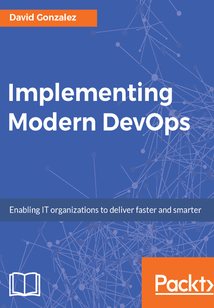舉報 

會員
Implementing Modern DevOps
最新章節:
What is next?
ThisbookiswrittenforengineersandcompaniesthatwanttolearntheminimumsetofrequiredtechnologiesandprocessestobesuccessfulintheDevOpsworld.Thisbookalsotargetssystemadministrators,developers,andITprofessionalswhowouldliketoemployDevOpstechniquesandbestpracticestomanageITinfrastructuresorwouldliketoacquirethenecessaryskillsneededtoworkinDevOpsteams.
最新章節
- What is next?
- Summary
- Monitoring Kubernetes clusters
- Monitoring applications
- Stackdriver
- AppDynamics
品牌:中圖公司
上架時間:2021-07-08 09:20:46
出版社:Packt Publishing
本書數字版權由中圖公司提供,并由其授權上海閱文信息技術有限公司制作發行
- What is next? 更新時間:2021-07-08 10:11:53
- Summary
- Monitoring Kubernetes clusters
- Monitoring applications
- Stackdriver
- AppDynamics
- Logentries
- Pingdom
- Monitoring third-party tools
- Whitebox monitoring
- Blackbox monitoring
- Types of monitoring
- Introduction
- Monitoring
- Summary
- Canary deployment
- Blue-green deployment
- Regular release
- Continuous delivery for your application
- Setting up Jenkins
- Setting up a continuous delivery pipeline for images
- Pushing the images to Google Container Registry
- Aggregator service
- ISO date and UTC date services
- The test system
- Playing against the statistics
- Release Management – Continuous Delivery
- Summary
- Kubernetes- moving on
- Secrets and configuration management
- Jobs
- PetSets
- Daemon Sets
- Other Building Blocks
- Services
- Deployments
- Replica Sets
- Deploying a pod
- Pods
- Kubernetes building blocks
- Setting up a cluster in GCP
- Kubernetes logical architecture
- Kubernetes
- Docker Swarm
- Why clustering ?
- Docker Swarm and Kubernetes - Clustering Infrastructure
- Summary
- Ansible Tower
- Roles
- Flow control
- Ansible templates
- Ansible remote facts
- Ansible variables
- Ansible variables remote facts and templates
- Ansible configuration
- Ansible
- Ansible
- Puppet
- Chef
- Server provision software
- Server Provisioning
- Summary
- Terraform outputs
- Terraform variables
- Modifying your infrastructure
- Remote state management
- Creating resources
- Terraform
- Creating resources with Google Cloud SDK
- Google Cloud Platform SDK - gcloud
- Infrastructure as Code
- Summary
- Other features
- Executing pipelines
- Running builds
- Installing Drone
- Drone CI
- Modern CI servers
- Secrets Management
- Jenkins
- Bamboo
- Traditional CI servers
- Testing types
- Software development life cycle
- Continuous Integration
- Summary
- Docker Compose
- User-defined networks
- Docker networking
- Docker volumes
- Private registries
- Public registries
- Docker registries
- Dockerfile reference
- Building Docker images
- Docker client
- Docker internals
- Docker architecture
- Docker
- Summary
- Azure
- DigitalOcean
- Heroku
- Other cloud providers
- Big data
- Machine Learning APIs
- Google App Engine
- Other Google Cloud Platform products
- Setting up a cluster
- Google Container Engine
- Networking
- Launching an instance
- Custom machines and GPU processing
- Shared-core machine types
- High-CPU machine types
- High-memory machine types
- Standard machine types
- Google Compute Engine
- Google Cloud Platform
- DynamoDB
- Amazon RDS
- Amazon ElasticCache
- CloudFront
- Route 53
- Other services
- Creating a cluster
- Amazon ECR and ECS
- Amazon S3
- Storage in AWS and EC2
- Networking in AWS and EC2
- Relational Database Service
- Launching an instance
- EC2 - computing service
- Amazon Web Services
- Cloud Data Centers - The New Reality
- Summary
- What to expect from this book
- DevOps: Organizational alignment
- DevOps and microservices
- Releasing new versions
- Agile development and communication
- Modern release management
- Releasing new versions
- The cost of fixing a bug
- Chain of communication
- Traditional release management
- DevOps and corporations
- DevOps origins
- What is DevOps?
- DevOps in the Real World
- Questions
- Piracy
- Errata
- Downloading the color images of this book
- Downloading the example code
- Customer support
- Reader feedback
- Conventions
- Who this book is for
- What you need for this book
- What this book covers
- Preface
- Dedication
- Customer Feedback
- Why subscribe?
- www.PacktPub.com
- About the Reviewer
- About the Author
- Credits
- Implementing Modern DevOps
- Copyright
- Title Page
- coverpage
- coverpage
- Title Page
- Copyright
- Implementing Modern DevOps
- Credits
- About the Author
- About the Reviewer
- www.PacktPub.com
- Why subscribe?
- Customer Feedback
- Dedication
- Preface
- What this book covers
- What you need for this book
- Who this book is for
- Conventions
- Reader feedback
- Customer support
- Downloading the example code
- Downloading the color images of this book
- Errata
- Piracy
- Questions
- DevOps in the Real World
- What is DevOps?
- DevOps origins
- DevOps and corporations
- Traditional release management
- Chain of communication
- The cost of fixing a bug
- Releasing new versions
- Modern release management
- Agile development and communication
- Releasing new versions
- DevOps and microservices
- DevOps: Organizational alignment
- What to expect from this book
- Summary
- Cloud Data Centers - The New Reality
- Amazon Web Services
- EC2 - computing service
- Launching an instance
- Relational Database Service
- Networking in AWS and EC2
- Storage in AWS and EC2
- Amazon S3
- Amazon ECR and ECS
- Creating a cluster
- Other services
- Route 53
- CloudFront
- Amazon ElasticCache
- Amazon RDS
- DynamoDB
- Google Cloud Platform
- Google Compute Engine
- Standard machine types
- High-memory machine types
- High-CPU machine types
- Shared-core machine types
- Custom machines and GPU processing
- Launching an instance
- Networking
- Google Container Engine
- Setting up a cluster
- Other Google Cloud Platform products
- Google App Engine
- Machine Learning APIs
- Big data
- Other cloud providers
- Heroku
- DigitalOcean
- Azure
- Summary
- Docker
- Docker architecture
- Docker internals
- Docker client
- Building Docker images
- Dockerfile reference
- Docker registries
- Public registries
- Private registries
- Docker volumes
- Docker networking
- User-defined networks
- Docker Compose
- Summary
- Continuous Integration
- Software development life cycle
- Testing types
- Traditional CI servers
- Bamboo
- Jenkins
- Secrets Management
- Modern CI servers
- Drone CI
- Installing Drone
- Running builds
- Executing pipelines
- Other features
- Summary
- Infrastructure as Code
- Google Cloud Platform SDK - gcloud
- Creating resources with Google Cloud SDK
- Terraform
- Creating resources
- Remote state management
- Modifying your infrastructure
- Terraform variables
- Terraform outputs
- Summary
- Server Provisioning
- Server provision software
- Chef
- Puppet
- Ansible
- Ansible
- Ansible configuration
- Ansible variables remote facts and templates
- Ansible variables
- Ansible remote facts
- Ansible templates
- Flow control
- Roles
- Ansible Tower
- Summary
- Docker Swarm and Kubernetes - Clustering Infrastructure
- Why clustering ?
- Docker Swarm
- Kubernetes
- Kubernetes logical architecture
- Setting up a cluster in GCP
- Kubernetes building blocks
- Pods
- Deploying a pod
- Replica Sets
- Deployments
- Services
- Other Building Blocks
- Daemon Sets
- PetSets
- Jobs
- Secrets and configuration management
- Kubernetes- moving on
- Summary
- Release Management – Continuous Delivery
- Playing against the statistics
- The test system
- ISO date and UTC date services
- Aggregator service
- Pushing the images to Google Container Registry
- Setting up a continuous delivery pipeline for images
- Setting up Jenkins
- Continuous delivery for your application
- Regular release
- Blue-green deployment
- Canary deployment
- Summary
- Monitoring
- Introduction
- Types of monitoring
- Blackbox monitoring
- Whitebox monitoring
- Monitoring third-party tools
- Pingdom
- Logentries
- AppDynamics
- Stackdriver
- Monitoring applications
- Monitoring Kubernetes clusters
- Summary
- What is next? 更新時間:2021-07-08 10:11:53


